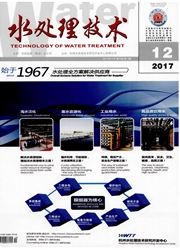

 中文摘要:
中文摘要:
以自制的净水污泥柱状颗粒和市售的活性氧化铝为生物填料,采用上流式曝气生物滤池(BAF)对污水厂水解酸化后的印染废水进行了好氧处理,比较了2种生物填料的挂膜效果及其生物膜形态和结构特征,考察了在稳态运行时的除污效能。结果表明,活性氧化铝填料挂膜成功需要25 d,微生物活性为27 mg/(g·h),净水污泥填料挂膜成功仅需18 d,微生物活性为33 mg/(g·h),净水污泥填料挂膜效果优于活性氧化铝填料。2种填料对COD的去除率分别为67.61%和67.43%,对NH3-N的去除率为62.49%和62.95%。净水污泥填料对色度的去除效果为74.80%,优于活性氧化铝填料67.70%。因此以净水污泥制备的新型填料可以代替市售活性氧化铝,具有应用到市场中的潜力。
 英文摘要:
英文摘要:
Dyeing wastewater pretreated with hydrolytic acidification was aerobic treated using up-flow biological aerated filter column (BAF). Cylindrical water purification sludge particle and activated alumina were used as filler separately in BAF. Parallel experiments were carried out to investigate the biofilm efficiency of the two biological filler and their biofilm morphology and structural characteristics. The removal efficiency of different fillers in BAF was examined. The experimental results revealed that WPS was superior to activated alumina in the membrane forming. It took about 25 d to succeed in cultivating bio-film using activated alumina with the microbial activity of 27 mg/(g,h), while it took 18 d only for WPS and its microbial activity can reach 33 mg/(g.h). The COD removal efficiency of WPS and active alumina were 67.61% and 67.43%, respectively, and NH3-N removal efficiency were 62.49% and 62.95%, respectively. The removal effect of WPS on chrominance could achieve 74.80%, which was superior to that of activated alumina (67.70%). Therefore, WPS could be a new potential packing material, which could replace activated alumina.
 同期刊论文项目
同期刊论文项目
 同项目期刊论文
同项目期刊论文
 Facile synthesis of uniform Pt nanoparticles onpolydopamine-reduced graphene oxide and their electro
Facile synthesis of uniform Pt nanoparticles onpolydopamine-reduced graphene oxide and their electro Simultaneous determination of dopamine and uric acid in thepresence of ascorbic acid using Pt nanopa
Simultaneous determination of dopamine and uric acid in thepresence of ascorbic acid using Pt nanopa Simple one-pot preparation of Pd-on-Cu nanocrystals supported on reduced graphene oxide for enhanced
Simple one-pot preparation of Pd-on-Cu nanocrystals supported on reduced graphene oxide for enhanced 期刊信息
期刊信息
